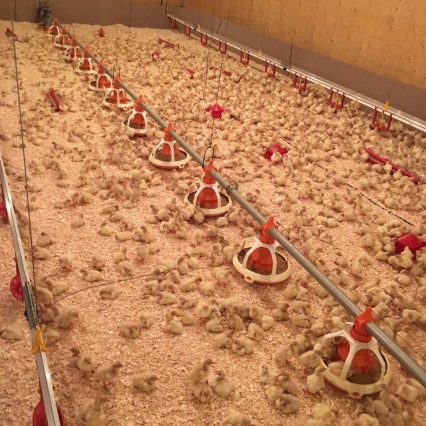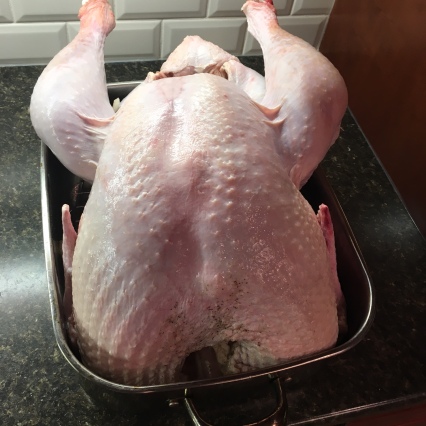How much do you want to know about your food? A turkey farmer’s voice #chooseCDNturkey
As a turkey farmer it is important to be able to share our family farm story. Talking about how we grow and care for our turkeys is important to me, because I am proud of what we do and most of all, love eating turkey with my family. With the likes of social media, our community and even within our family it is not hard to be a part of the conversation or see the many posts about our birds and farm. However last night I took the opportunity to view the W5 program on CTV called ‘Fowl Business’ where our industry has been criticized for our handing of live turkeys from the farm to plate, mostly through the shackling and live stunning process at slaughter. My initial reaction was more mixed than I had anticipated, given our industry is directly impacted by consumer perceptions and influenced by media; perhaps there was some truth to this story.
I encourage you to watch this footage where the program relies on a ‘whistle blower’ from Mercy for Animals; an organization whose main purpose is to convert people into veganism. I could focus on the inaccuracies and clear bias presented by this organization as there were many, with an effort that W5 counterbalanced by the famous Temple Grandin, or focus on the food itself and how consumers connect to their meals which I think is more effective, long term. As a farmer, the company implicated in the report was Lilydale, a Sofina Foods owned company; a sister firm to the buyer of most of our birds.
To clarify a couple of points first; I take great issue with undercover employees, with direct motives to identify irregularities in meat processing systems while knowingly be supported by Mercy For Animals. As well, the Lilydale employee, who was referenced a number of times, should most certainly be reprimanded and I am sure no longer works for the firm based on his actions and general lack of concern for the animals. However, in reality we are always looking for the exception where rules are broken and people are not respecting the care and compassion for the animals.
However, the reality is the entire meat sector suffers from a similar crisis; their business of transforming a living animal into food, which for most people is not a nice process to watch! Sure, we all love the end product on the BBQ, but connecting consumers to where their food comes from stops short of the animal leaving the farm. Even as a farmer, after my turkeys are loaded on the truck, it is truly not my responsibility to what happens to them afterwards. What I do consider is ensuring that as close to 100% of the birds and meat were of superior quality as possible. As turkey farmers, I have personally undergone safe handling and loading of turkeys courses, not to mention our on farm food safety protocols, which include all animals be respected and those suffering must be immediately and humanly euthanized on farm.
Recently, farm commodity boards through media campaigns have been launched to share farmer stories, bring consumers, the media and influencers on farm to share real stories of the people that truly care about our food system. I truly believe that we have a great story to tell on farm, but it begs the question, how much information is enough and how much is too much?
As a farmer, my primary goal is to raise healthy and productive turkeys; I do everything possible to maintain a positive environment for them including nutrition, housing, bedding and even medication if it is required, the last thing I like seeing on my farm are sick or dead birds. So when it comes to slaughtering the turkeys, it is a difficult sight to watch; I don’t like blood in general and there are different sights, smells, movement and noises that come with the slaughter and processing of livestock. So like other consumers, the slaughter part of food production is never talked about, let alone seeing video footage of this stage. To me, the ‘Fowl Business’ highlights the fact that living animals die for us to eat them, let alone the issues they highlighted of the perceived mishandling.
This past April, I had the privilege of visiting the largest turkey processors in Germany. It is estimated that 60,000 turkeys are handled per day, which equates to the entire Canadian production in about 7 months at this one facility. Through using controlled atmospheric stunning, the facilities operated with utmost efficiency. When I spoke to the marketing manager, I asked “What message do you want me leaving the visit with?” His response was simple, that we value animal welfare from farm to plate and that their facility employs the latest technology which promotes efficient output of quality meat products. The visit in Germany left me with one on the most positive feelings regarding turkey meat, in that it was not a stomach turning, ethically questioning experience!
As an industry, I am interested to learn how Lilydale/Sofina will react to this news report, at the same time look forward to an overall industry reaction as I do believe it may be turkey today, but can easily be hogs or beef or chicken tomorrow. Yet at the same time, as a farmer, I am proud of our accomplishments on farm, yet we will only be successful in the future if we are part of an entire value chain that is effective at communicating our standards and expectations to all consumers, at the same time respecting their potential views on humane treatment of animals through the entire lifecycle.
The CTV show W5 called ‘Fowl Business’ continues to irritate me by relying animal rights group spies and unfortunate employees that either lack training and demonstrate unacceptable behaviors to speak about the humane issues of turkey. At the same time there are reasons we pay for Canadian Food Inspection Agency, work within organized marketing boards and abide by every increasing animal welfare protocols on farm that must work as succinct systems. I willingly continue to share our farm story in efforts of helping connect people with their food. Unfortunately delivering the message around the transformation from alive to dead is a difficult story to comprehend, but we must remember our food story does not end at the farm nor start at the grocery store.









